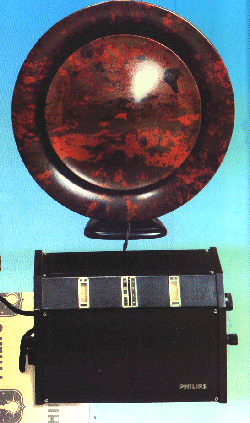
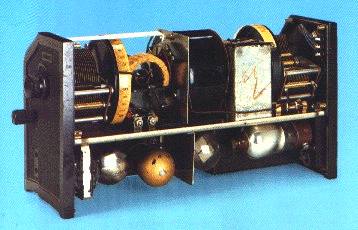


Brand and type: Philips 2514. The picture comes from a Philips issue, and shows exactly the radio and loudspeaker I own. It's almost equal to Philips' first born, type 2502 from 1927. Except for the built-in power supply of the 2514. That's why the 2514 is 6 cm wider than the preceding model. Nowadays quite a few are left over, in spite of the German action during WWII to expropriate all radios in Holland, able to receive other than their own propaganda stations. After all this small radio could be hidden everywhere: in the chimney, chicken shack, or even buried...
Speaker: Type 2007. Introduced in 1926, before any radio left the factory. Philips made it very clear: besides a loudspeaker, this was considered to be an "object of art" as well. It's all bakelite, renamed by Philips to Philite, except for the iron foot. It has a triple lead, the plug contains a switch to select different impedances. The electro-magnetic system and paper cone are between the two disks. Diameter of the bigger disk is 45 cm. More than 240,000 were produced, in various colors: purple, pink, red or green were also possible. No 2 similar speakers can be found, they all differ in their cloudy pattern. Simply because of being hand-made.
If the sound is too shrill for your ears, just connect the additional
"tone sieve" type 4004 between speaker and radio. This device was mounted
in a simple plug and gives a warmer sound.
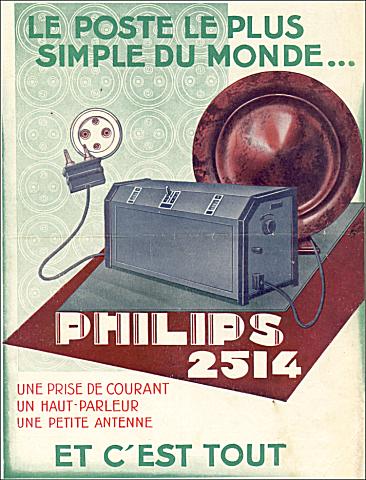
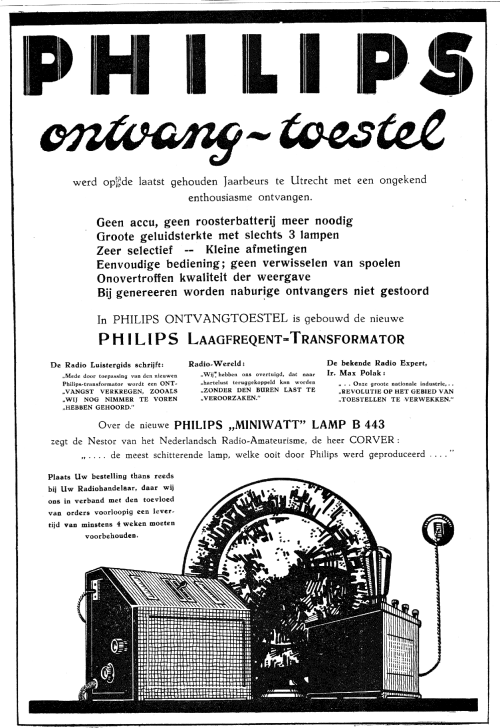
Produced: The Netherlands, 1928. In fact, this radio was way ahead of designs only 2 years older. Take a look at another Dutch radio from that era, the NSF M3 from 1926, which is rather oldfashioned compared to the smart 2514. Of course the discomfort of interference caused by your neighbour wasn't banned out with this radio, but overall it was a much better and professional design.
Cabinet: Front and back steel plate covered with linen as used on books, bakelite side panels. A guy named L. Kalff designed it.
Some years later, this same designer decided that radios had to be part of the furniture and thus should look like. Of course he had been looking around abroad. After all the wife in the house couldn't stand all these technical mess: wires, batteries, coils, tools (what in fact never has changed through the following decades, despite of all emancipation!). So the radio had to be integrated into a harmonic family life: radios changed from black to brown, and all the creepy stuff was built inside, only leaving a few knobs outside for the housewife. Which she could easily operate: on/off, volume and tuning control. I remember my grandma never touching the 40's radio, that was grandpa's domain. He wasn't a great listener: every day from 19.00 untill 19.10, he was consuming the local news. After that, he turned the radio off. I never caught him turning the tuning knob.
Tubes: E442 tetrode (RF-stage) - E428 triode (detector) - L445d, substitutes the Philips-type B443 (output stage) - 506K full wave rectifier. All tubes are Philips makes except the output which is from Valvo. Sometimes you see a 2514 with holes roughly cut into the body, to allow bigger replacement tubes!
Power: AC from 111 to 253 volts. Strange values! There's also a DC version of this radio, called 2524. In this case the rectifier is replaced by a resistance tube, type 1904 from Swan.
Bands: Medium and long waves from 200 to 2000 meters.
Controls: Primary and secondary tuning capacitor,
positions are visible on 2 small dials on left and right. Each scale shows
digits from 0 to 180. RF-feedback Volume control by a variable resistor
in the RF-tube filament. Bandswitch in the middle on top with positions
200-400, 300-600 and 1000-2000 meters. Three receptables for the antenna
plug.
No fooling around with a whole range of plug-in coils, these are built-in.
Condition:Very good.
Working: Great - this radio is rather sensitive. Of course the selectivity isn't stunning. Although it was meant to be used with an outdoor antenna, it plays well on a short wire, even a knitting needle will do. Obviously not a modern plastic one .....

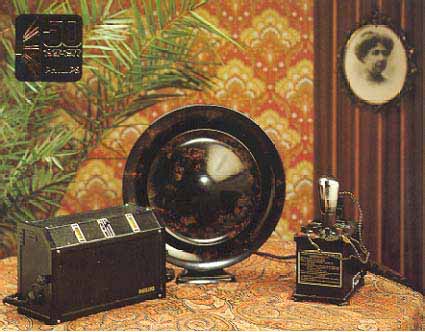
Email ||
||